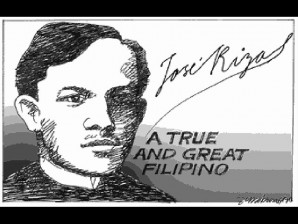The first Filipino
It is difficult to imagine the Philippines without Jose Rizal; it is certainly impossible to understand our country – our shortcomings as well as our sources of hope and possibility – without the work of the man and martyr whose birth 150 years ago we celebrate today.
The vivid characters he created in his two subversive (and now world-famous) novels still people Philippine society: the superstitious capitalist and the naive idealist, the ignorant zealot and the overbearing priest, the ridiculous pretender and the cruel mistress, the noble native and the long-suffering mother, the wise counselor and the ambitious student, the power-addicted journalist and the vengeful terrorist.
Article continues after this advertisementThe themes he took up in his writings continue to vex Filipinos today: the balance between peaceful change and armed uprising; the relationship between virtue and redemption; the struggle between colony and empire, between periphery and center; the tension between the faith that gives life and the faith that kills.
Above all, the consciousness he helped shape, that sense of nation that he helped foster, define the Philippines as it is today. Rizal has been called, by one of his most influential biographers, as the First Filipino, and there is much truth in the title: If a nation is in fact an imagined community, then the writings, the personal example and above all the martyrdom of “Doctor Rizal” form one of the binding elements of the national imagination.
A survey conducted by Social Weather Stations last March provides resonant confirmation. Asked to name genuine Filipino heroes, an overwhelming 75 percent of all respondents named Rizal; Andres Bonifacio came in second at 34 percent and Benigno “Ninoy” Aquino Jr. third at 20 percent. The pattern was repeated in each of the major geographic regions: 74 percent of respondents in Metro Manila named Rizal, 79 percent in the rest of Luzon, 78 percent in the Visayas, and (only) 68 percent in Mindanao, where Rizal had spent the last four years of his short life in exile and whose languages and complicated history drew his scientific curiosity. The pattern held in the demographic classifications too: 70 percent in class ABC, 75 percent in D, 79 percent in E.
Article continues after this advertisementWe daresay Bonifacio, if he had lived long enough, would have welcomed the results; he too saw Rizal as guide and inspiration.
We remember Rizal every year on his death anniversary; in fact, Filipinos have been doing so since 1897, or a mere year after his execution, when the revolutionaries who fought the Spanish army (and then eventually the American expeditionary forces too) paid tribute to Rizal on the anniversary of his martyrdom. But it is also important to remember that, to an extraordinary extent, Rizal lived a heroic life – that is to say, one that was always dedicated to the primary task of forming a nation.
Three letters to Marcelo H. del Pilar, the editor of La Solidaridad and with Rizal the leader of the Propaganda Movement, serve as stirring reminders of that daily commitment:
• January 1889: “Escribi el Noli me tangere para despertar los sentimientos de mis paisanos – I wrote the Noli Me Tangere to rouse the feelings of my countrymen.”
• June 11, 1890: “Ang ina nati’y nasasanla; kailangang ating tubusin muna, bago tayo makapag aliw – Our mother has been mortgaged; we need to redeem her first, before we can entertain ourselves.”
• Aug. 12, 1891: “Yo lucho por la nacion, Filipinas.” To the average, non- Spanish-speaking Filipino, only the second word may prove difficult, but everything else can easily make sense. “I fight for the nation, the Philippines.”
Rizal did not have to return to the Philippines after publishing the Noli, but he did, twice. Before he returned the second time, he wrote to his fellow expatriates in Tagalog; one of the most important letters Rizal ever wrote, this October 1891 letter explains his decision to return yet again to the Philippines, even at the risk of exile or death.
“Ang parang na paglalabanan ay ang Filipinas: doon tayo dapat magtatagpo – The field of battle is the Philippines: that’s where we should meet.”
In other words, having chosen to dedicate his life to his country, he chose the fate that would lead him, five years later, to the killing field of Bagumbayan.
















